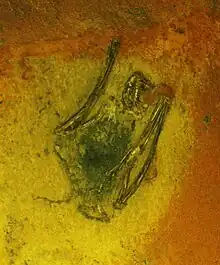Hassianycteris
Hassianycteris is an extinct genus of Early Eocene (Ypresian) bats from the Hassianycterididae with two or three known species: the type (H. messelensis), found in the Messel pit, Germany,[1][2] H. kumasi, found in the Cambay Shale Formation (Vastan Lignite Mine), India,[3] and the possible third species "H." joeli, found in the Kortijk Clay Formation, Belgium.[4] Alongside Palaeochiropteryx tupaiodon (alive roughly 48 million years ago), P. tupaiodon and Hassianycteris kumari are the first fossil mammals whose colouration has been discovered: both were reddish-brown when alive.[5][6] H. messelensis was probably a similar colour when alive.
| Hassianycteris Temporal range: Early Eocene, | |
|---|---|
 | |
| Specimen of H. messelensis from the Messel Pit of Germany | |
| Scientific classification | |
| Domain: | Eukaryota |
| Kingdom: | Animalia |
| Phylum: | Chordata |
| Class: | Mammalia |
| Order: | Chiroptera |
| (unranked): | Microchiropteramorpha |
| Family: | †Hassianycterididae |
| Genus: | †Hassianycteris Smith & Storch, 1981 |
| Species | |
| |
References
- Smith, J.D. Storch, G. (1981): New Middle Eocene bats from “Grube Messel” near Darmstadt, W-Germany. Senckenbergiana biologica, 61 (3/4): 153-167.
- Richter, G. & Storch, G. (1980): Beiträge zur Ernährungsbiologie eozäner Fledermäuse aus der "Grube Messel". Natur und Museum, 110 (12), p. 353-367
- T. Smith, R. S. Rana, P. Missiaen, K. D. Rose, A. Sahni, H. Singh, and L. Singh. 2007. High bat (Chiroptera) diversity in the Early Eocene of India. Naturwissenschaften 94(12):1003-1009
- T. Smith and R. Smith. 2003. Terrestrial mammals as biostratigraphic indicators in upper Paleocene-lower Eocene marine deposits of the southern North Sea Basin. Geological Society of America Special Paper 369:513-520
- "Paleontologists Determine Original Color of Extinct Bats". SciNews. 29 September 2015. Retrieved 10 September 2017.
- Colleary, C.; Dolocanc, A.; Gardnerd, J.; Singha, Suresh; Wuttkee, M. (2015). "Chemical, experimental, and morphological evidence for diagenetically altered melanin in exceptionally preserved fossils". Proceedings of the National Academy of Sciences of the United States of America. 112 (41): 12592–12597. Bibcode:2015PNAS..11212592C. doi:10.1073/pnas.1509831112. PMC 4611652. PMID 26417094.
This article is issued from Wikipedia. The text is licensed under Creative Commons - Attribution - Sharealike. Additional terms may apply for the media files.